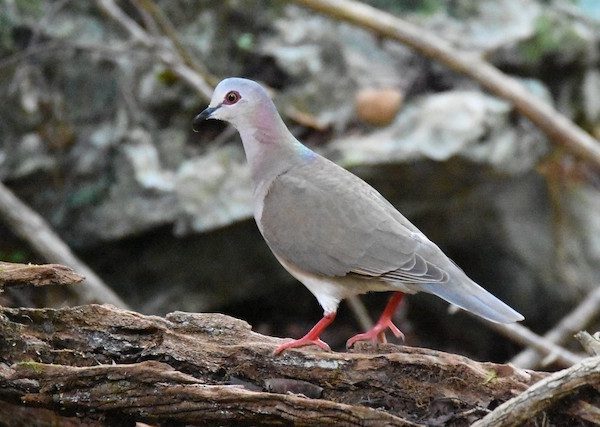Birdfinding.info ⇒ A form of Caribbean Dove that is very common on Cozumel and readily found at sites such as San Gervasio and El Cedral. Can also be found on Isla Mujeres and along the coast between Cancún and Playa del Carmen. Uncommon in Belize and Honduras, mainly on Ambergris Caye and Roatán Island.
“Yucatán Dove”
Leptotila jamaicensis gaumeri
Endemic to the Yucatán Peninsula and adjacent islands from Holbox to Ambergris Caye, and the Honduran Bay Islands.
On the Yucatán Peninsula, occurs nearly throughout the states of Yucatán and Quintana Roo, and in eastern Campeche, south into north-central Guatemala, and northeastern Belize. Especially numerous on Cozumel.
Among the Bay Islands, known mainly from Roatán, its eastern islets, and the Cayos Cochinos, but has also been reported from Utila and Guanaja.
Identification
Typical Leptotila pattern and coloration, but with a whitish face and blue-gray crown. Has a rosy, iridescent blush on the nape and sides of the neck that shades into rainbow-colored iridescence on the mantle.
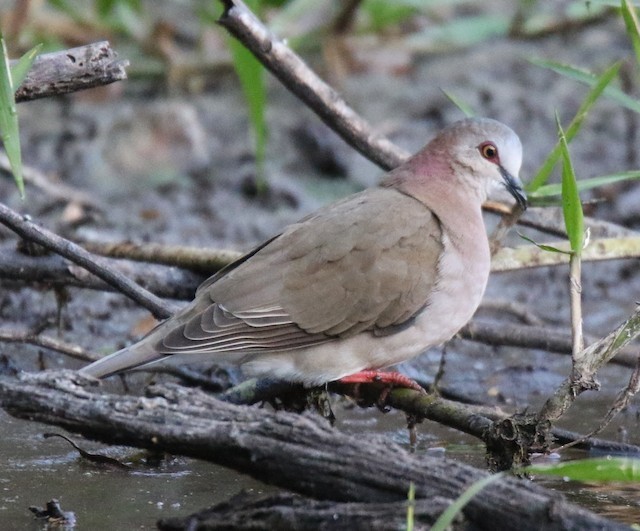
“Yucatán Dove,” L. j. gaumeri, showing typical, though muted, coloration. (Hormiguero Archaeological Zone, Calakmul Biosphere Reserve, Campeche, Mexico; February 1, 2017.) © Jim Stasz
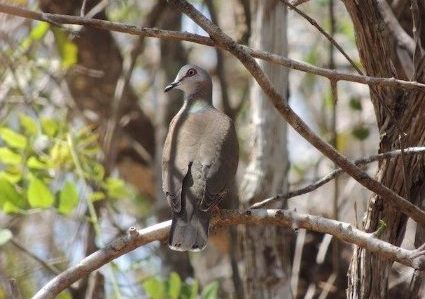
“Yucatan Dove,” L. j. gaumeri, showing the prominence of its whitish face. (Reserva Xocén, Yucatán, Mexico; March 24, 2018.) © Ismael Arellano Ciau (Ichi Tours/Keep Birding)
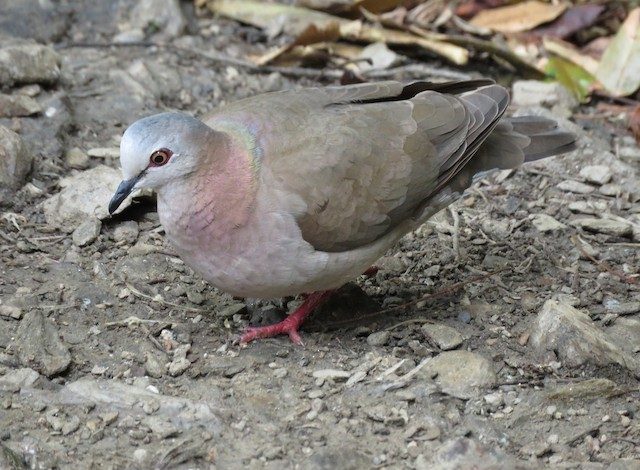
“Yucatan Dove,” L. j. gaumeri, showing blue-gray crown and rainbow iridescence on mantle. (Cayo Cochino Mayor, Honduras; April 20, 2017) © Jafeth Zablah
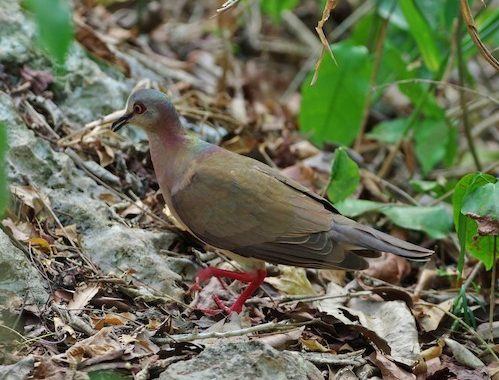
“Yucatan Dove,” L. j. gaumeri, showing blue-gray crown, rosy blush on neck, and rainbow iridescence on mantle. (Punta Laguna, Santuario de Mono Araña, Quintana Roo, Mexico; March 9, 2018.) © Thibaud Aronson
“Yucatán Dove” shows unusual variability in the tones of its plumage.
Some individuals have evenly colored upperparts and underparts; others have strongly contrasting dark upperparts and pale underparts.
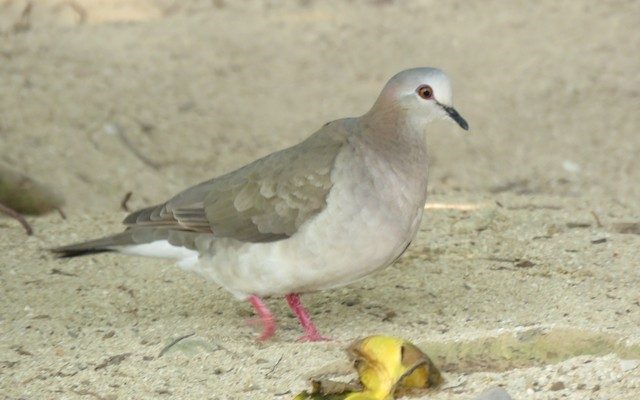
“Yucatan Dove,” L. j. gaumeri, with somewhat uniformly sandy-gray plumage. (Cayo Cochino Mayor, Honduras; April 16, 2016) © Jafeth Zablah
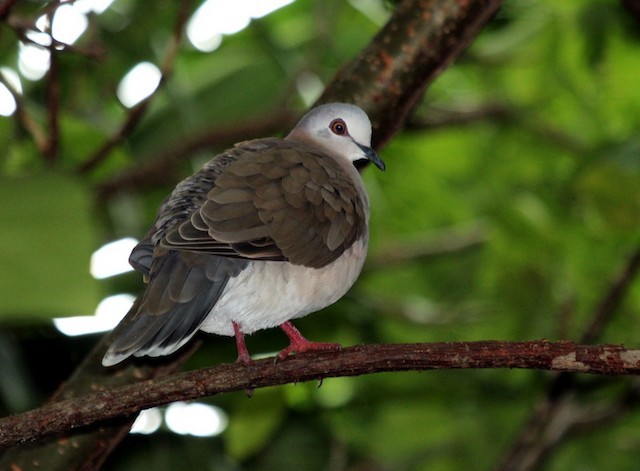
“Yucatan Dove,” L. j. gaumeri, with strong contrast between pale underparts and dark upperparts. (Cancún, Quintana Roo, Mexico; September 18, 2013.) © Rolando Chávez
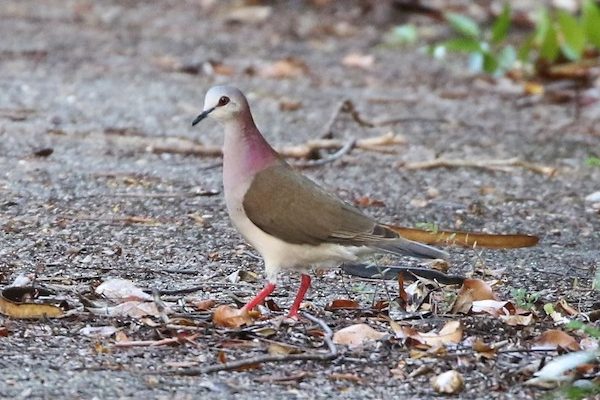
“Yucatan Dove,” L. j. gaumeri, showing a vivid rosy blush on the neck (generally resembling “Red-necked Dove”). (San Miguel, Isla Cozumel, Quintana Roo, Mexico; February 27, 2018.) © Tom Benson
Some have a vivid rosy blush on the neck.
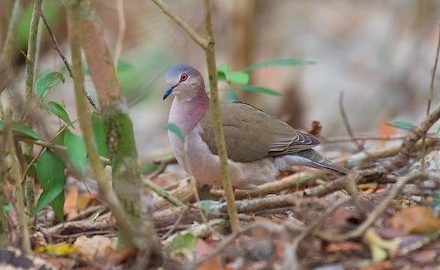
“Yucatan Dove,” L. j. gaumeri, an individual with a vivid rosy blush on the neck and unusually blue crown. (Reserva Xocén, Yucatán, Mexico; March 9, 2018.) © Rolando Tomas Pasos Pérez
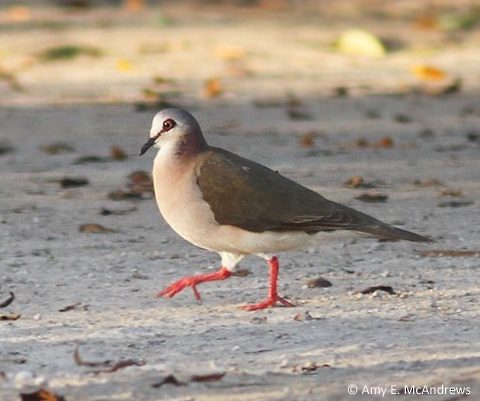
“Yucatan Dove,” L. j. gaumeri, with strong contrast between pale underparts and dark upperparts. (El Cedral, Cozumel, Quintana Roo, Mexico; May 25, 2014.) © Amy E. McAndrews
Some have entirely immaculate white underparts and grayish upperparts.
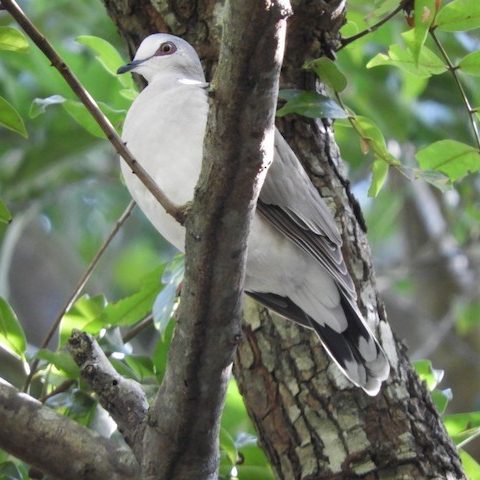
“Yucatan Dove,” L. j. gaumeri, an individual with immaculate white underparts and grayish upperparts. (Zona Arqueológica Oxtankah, Quintana Roo, Mexico; December 22, 2017.) © Luis Trinchan
Some are warm-brown above and below.
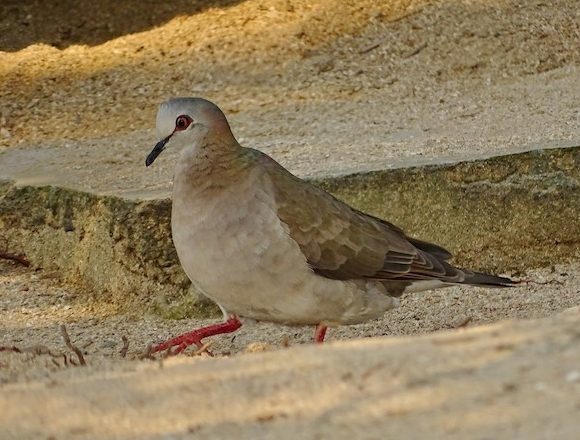
“Yucatan Dove,” L. j. gaumeri, an individual with somewhat uniformly warm-brown underparts and upperparts. (Cayo Cochino Mayor, Honduras; April 16, 2016) © Alfonso Auerbach
Voice. Typically gives a four-note call. Often a descending series accented on the second syllable, cu-COO-cu-coo:
Also often gives a more monotone four-note series, with the last note somewhat longer: coo-coo-coo-cooo. This type of series is sometimes abbrieviated to three notes: coo-coo-cooo.
Cf. Other Leptotila Doves. On the Yucatán Peninsula, “Yucatán Dove” overlaps widely with White-tipped, more narrowly with Gray-headed, and possibly also with Gray-chested. If seen clearly, “Yucatán’s” blue crown and rosy neck would be diagnostic. However, as discussed above, its coloration is highly variable, and Leptotila doves encountered in the field are often difficult to see clearly, so this feature is rarely useful in identification.
Voice is a far more reliable identifying characteristic. Gray-headed has a brief monosyllabic call, repeated frequently (intervals of 2 seconds or less). White-tipped usually gives a two-syllable call, with the second note much more drawn-out. “Yucatán” usually give a four-note call. Some alternate calls of both White-tipped and “Yucatán” are three syllables, but the cadences differ.
Notes
Monotypic form, one of three potentially distinct forms of Caribbean Dove.
Frontiers of Taxonomy: Caribbean Dove.
The Caribbean Dove (Leptotila jamaicensis) includes four well differentiated subspecies that are geographically isolated and evidently diverging toward full speciation. Thus far, taxonomic authorities have not emphasized the remarkable differences among them—differences that seem facially sufficient to merit the recognition and awareness that individual common names confer.
Pending further research, I suggest provisional recognition of three distinct forms of Caribbean Dove:
“Red-necked Dove,” L. j. jamaicensis (including collaris): The two subspecies native to Jamaica and the Cayman Islands are mostly similar to one another in plumage and voice. Both have a bold white bar on the side of the chest and a contrasting reddish swath on the nape and sides of the neck that gleams with iridescence: rosy (varying from magenta to coppery) on the sides and yellow, green, and blue on the back. Both primarily sing a monotone three-note call.
“Yucatán Dove,” L. j. gaumeri: The subspecies native to the Yucatán Peninsula and Honduran Bay Islands differs from jamaicensis and collaris in its basic plumage pattern, as it has no white bar on the side of the chest and its neck is far less colorful and contrasty—it has only a slight reddish tone, but is similarly iridescent and gleams with approximately the same colors as on jamaicensis and collaris. It primarily sings a four-note call with inflected phrasing. Gaumeri is notably variable in appearance and vocalizations.
“San Andrés Dove,” L. j. neoxena: The subspecies confined to Isla San Andrés differs from the others in plumage pattern and color, as it has no white bar on the side of the chest and its neck is plain grayish-brown, with a smaller iridescent patch that is yellow, green, and blue—entirely lacking the red tones that predominate on the other forms. It primarily sings a four-note call with inflected phrasing. Neoxena appears to be little-studied, with only a handful of publicly available photographs and recordings. In light of its tiny range and shrinking habitat area, it is likely nearing extinction.
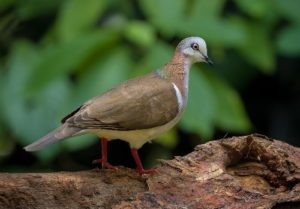
“Red-necked Dove,” L. j. jamaicensis. © Ignacio Yúfera
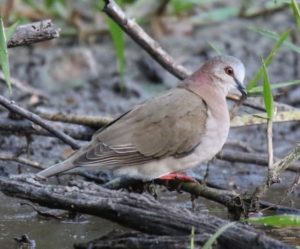
“Yucatán Dove,” L. j. gaumeri. © Jim Stasz
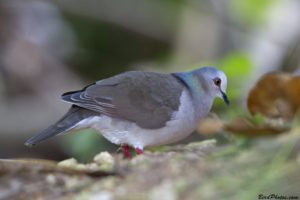
“San Andrés Dove,” L. j. neoxena. © Tom Friedel
References
Baptista, L.F., P.W. Trail, H.M. Horblit, and P. Boesman. 2018. Caribbean Dove (Leptotila jamaicensis). In Handbook of the Birds of the World Alive (J. del Hoyo, A. Elliott, J. Sargatal, D.A. Christie, and E. de Juana, eds.). Lynx Edicions, Barcelona. https://www.hbw.com/node/54236. (Accessed January 13, 2018.)
Bonta, M., and D.L. Anderson. 2002. Birding Honduras: A Checklist and Guide. EcoArte S. de R.L.
eBird. 2019. eBird: An online database of bird distribution and abundance. Cornell Lab of Ornithology, Ithaca, N.Y. http://www.ebird.org. (Accessed January 18, 2019.)
Fagan, J., and O. Komar. 2016. Peterson Field Guide to the Birds of Northern Central America. Houghton Mifflin Harcourt, New York.
Gibbs, D., E. Barnes, and J. Cox. 2001. Pigeons and Doves: A Guide to the Pigeons and Doves of the World. Yale University Press, New Haven, Connecticut.
Howell, S.N.G. and S.W. Webb. 1995. A Guide to the Birds of Mexico and Northern Central America. Oxford University Press, Oxford.
